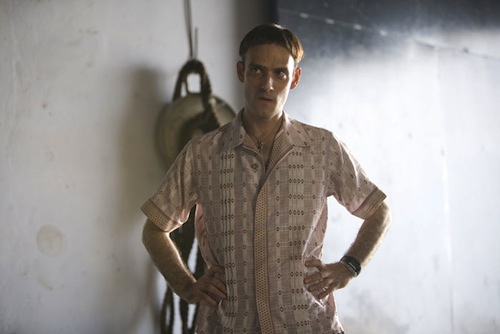Directed by Guillermo del Toro
Written by Travis Beacham and Guillermo del Toro
USA, 2013
If Calvin and Hobbes, those most delightful and beloved comic-strip characters, made a monster movie out of one of their fever-dream playtime japes, it would probably look a great deal like Pacific Rim. The sweaty, breathless determination with which the film’s main concept plays out, as well as how frequently it aims to top itself, is both charming and a mild hindrance. (Cartoonist Bill Watterson was able to get away with such boyhood tomfoolery because he was working with a much shorter amount of space and time.) Co-writer and director Guillermo del Toro has broken free of his almost quaint, homemade style in Pacific Rim, delivering, in many ways, the ultimate summer movie, for good and ill.
In the not-so-distant future, our world has been changed due to a breach that connects Earth with an alien planet thanks to some shifting underwater tectonic plates. There be monsters through that gateway, truly vicious, bloodthirsty characters dubbed Kaiju, per decades of anime. Though humankind was initially caught unawares, they eventually fought back by building massive robots manned by two pilots, called Jaegers. By 2025, however, the fight has become more futile, with the Jaeger program on the outs, deemed too costly and unproductive by world authorities. As a last resort, the program’s leader (Idris Elba) calls in an ex-Jaeger pilot (Charlie Hunnam) to help out on a last-ditch effort to rid Earth of the Kaiju forever. The hero, of course, has personal demons to exorcise, as does his rookie co-pilot (Rinko Kikuchi). And Elba, as the gruff leader, has a past, even as he’s lecturing Hunnam about being too risky and unwilling to stick to the protocol.
So yes, Pacific Rim is touched with familiarity, as if del Toro and co-writer Travis Beacham combined every summer blockbuster and their built-in clichés, threw those ingredients into a blender, and allowed the result to spill onto the page. The cast, also including Charlie Day and del Toro stalwart Ron Perlman, do their best when the Jaegers and Kaiju aren’t duking it out to elevate the material, and a good portion of the time, they’re successful. Some of the flourishes within the script—naming one of the tweedy scientists after a character from the Marx Brothers comedy A Night at the Opera, for example—are charming by themselves, even when the dialogue feels awfully clunky. Among the actors, Elba and Kikuchi impress most of all, as their backstories allow them to breathe a bit more life into the parts they have to play. Hunnam is adequately tortured here, but compared to his work on Sons of Anarchy, it’s a little bland.
But in a lot of ways, Pacific Rim is less interested in building three-dimensional characters than it is with setting up the world of the film and then allowing robots and monsters to kick ass within that environment. The most thrilling sequence, easily the film’s high point, is when a number of Kaiju cross over into Earth and land in Hong Kong, ready to destroy as much of the massive metropolis as possible. The ways in which del Toro shoots the action here, as well as how he and Beacham pile obstacle on top of obstacle, is what makes the lengthy setpiece childishly, deliriously exciting. It is, in essence, a cinematic version of a little boy concocting outlandish scenarios for his toys while splashing them with an endless supply of water. As concocted by Guillermo del Toro, the sequence is a visceral delight. If anything, the only letdown is that the rest of the movie isn’t as consistently, relentlessly entertaining.
And then there is the 3D factor, which is not only unnecessary (outside of one enhanced effect) but dims much of the action. Seeing as the battles take place at night, in the rain, or underwater, it’s pointless and distracting, as the story goes with most post-conversions. Pacific Rim cries out for a battle shot and set during a crisp summer day, at least. The majority of the film eschews most of the excessive stylistic flourishes littering other big-budget movies, though del Toro does indulge in the now-overdone CGI zoom in the second half. The effects are also quite striking, even if they’re constantly shrouded in droplets of rain; the only time when effects are painfully noticeable is when the robots and monsters aren’t even on screen, just humans standing against obvious green screens.
Pacific Rim stands apart, somewhat, from the rest of Guillermo del Toro’s filmography. Gone are effects that charm and delight because they look scrapped together from spare parts, and gone—mostly—is the cutting, fierce emotion that made his greatest film, Pan’s Labyrinth, stand out so strongly back in 2006. Pacific Rim is big, loud, intense, and rooted in the ethos of the summer blockbusters that have defined the American movie marketplace for the last 30 years. But del Toro has the chops, wielding his camera around and through gargantuan fighting machines and sequences. In the past, Guillermo del Toro has made films that mix a child’s sense of wonder with a cynical worldview. In Pacific Rim, he’s overdosed on wonder and left cynicism in the dust, offering up a decent, sometimes-masterful child’s plaything.
— Josh Spiegel







